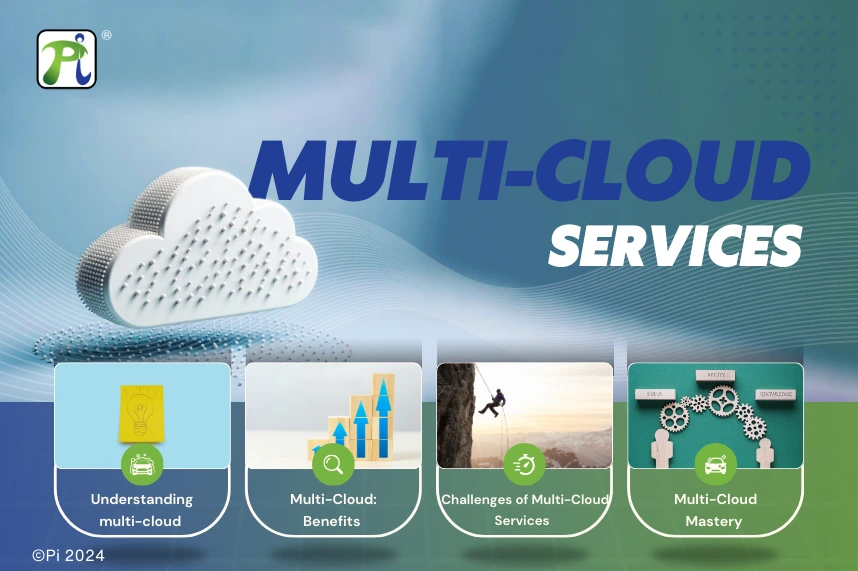
Multi-Cloud Services: A Modern Business Need
Multi-cloud services utilize cloud computing resources from multiple cloud providers, allowing organizations to distribute their computing workloads, applications, and data across several cloud platforms. This strategy is distinct from hybrid cloud, which typically involves combining on-premises infrastructure with public cloud services. Multi-cloud specifically uses multiple public cloud providers, such as AWS, Google Cloud Platform, Microsoft Azure, IBM Cloud, and others.
Let's Understand Multi-cloud
Dive into the world of "multi-cloud" strategy, where businesses unlock a realm of possibilities by seamlessly integrating diverse cloud services within a unified IT framework. Discover how this approach offers heightened adaptability, scalability, and enhanced security, all while driving cost efficiencies. Leveraging multiple cloud platforms, mitigating vendor lock-in risks, and future-proofing IT infrastructure for changing business demands can boost agility and innovation. Embrace the power of multi-cloud and stay ahead in today's dynamic digital landscape!
It’s Valuable Contribution as a Service
Multi-cloud services refer to the practice of using many cloud computing platforms and services simultaneously from different providers. This strategy allows enterprises to allocate their workloads, apps, and data among various cloud environments, taking advantage of each provider's distinct advantages and capabilities. A comprehensive analysis of multi-cloud services includes their benefits, intricacies, and suggested approaches for best deployment.
Its Benefits
Reliability/Redundancy:
A company's digital horizons are expanded when it adopts a multi-cloud deployment approach, which reduces dependency on a single provider and increases agility, innovation, and dependability.
Avoid Vendor Lock-In:
Migration to the cloud necessitates dependence on external cloud service providers as organizations increasingly adopt these vendors. However, a multi-cloud strategy entails the distribution of systems and storage across many vendors. As a result, migrating from one of these vendors is more straightforward, as most of the infrastructure remains intact throughout the process.
Potential cost savings:
A multi-cloud approach allows businesses to choose affordable cloud services from multiple providers, maximizing spending and decreasing vendor dependence. This technique leverages provider strengths for flexibility, scalability, and performance optimization. This improves risk mitigation, innovation, and agility, providing continuity and resilience to cloud infrastructure deployment.
Flexibility and Agility:
A multi-cloud strategy optimizes cost-effectiveness, reduces vendor lock-in, enhances flexibility, scalability, and performance optimization, mitigates risks, promotes innovation, and enables efficient adaptation to evolving business needs.
Geographic Resilience:
Spreading workloads across different cloud regions or data centers makes the system more resilient to disasters. If there is a problem in one area, services can be moved quickly to another location without any issues. As a result, companies that depend on cloud services can expect less disruption to their operations and more seamless functioning.
Performance Optimization:
Organizations can optimize performance by leveraging each cloud provider's unique capabilities, such as specialized AI/ML services, high-performance computing, or region-specific data storage options.
Compliance and Data Sovereignty:
Multi-cloud strategies enable compliance with data sovereignty regulations by storing data in specific regions or cloud providers that adhere to regulatory requirements, ensuring data privacy and compliance.
Challenges of Multi-Cloud Services
Complexity:
Managing multiple cloud environments introduces complexity in terms of governance, security, integration, and resource orchestration. It requires specialized skills and robust management tools to streamline operations effectively.
Interoperability:
Ensuring seamless interoperability and data exchange between cloud platforms and services can be challenging, requiring standardized APIs, data formats, and integration frameworks.

Cost Management:
While multi-cloud offers cost optimization opportunities, it can lead to cost sprawl if not managed efficiently. Organizations need robust cost monitoring and optimization strategies to control expenses across multiple cloud providers.
Security and Compliance:
Securing data, applications, and workloads across diverse cloud environments requires robust security measures, identity management, encryption, and compliance controls. Maintaining consistency in security policies and practices is crucial.
Vendor Management:
Managing relationships, contracts, SLAs (Service Level Agreements), and support across multiple cloud vendors necessitates effective vendor management practices to ensure service quality, accountability, and responsiveness.
Why Do We Need Multi-Cloud Mastery?
Mastering multi-cloud environments is crucial for businesses to mitigate risks, optimize performance, manage costs effectively, enhance security, comply with regulations, foster innovation, and improve overall operational efficiency. This strategic approach empowers organizations to leverage the strengths of multiple cloud providers, creating a more resilient, flexible, and competitive IT infrastructure. Here, we are enlisting how Multi-cloud Mastery can help businesses achieve their desired business goals and realize the ROI
Strategic Planning:
Define clear objectives, workload suitability, and deployment criteria for each cloud environment based on business requirements, performance needs, compliance, and data residency considerations.
Governance and Management:
Implement centralized governance, policies, and automation tools to manage multi-cloud environments effectively. Establish consistent security controls, compliance standards, and resource allocation policies.
Interoperability and Integration:
Prioritize interoperability and seamless integration between cloud platforms using standard APIs, data formats, and integration frameworks. Leverage cloud-native services and tools for data movement and synchronization.
Cost Optimization:
To achieve ROI, develop cost optimization strategies, monitor usage patterns, leverage reserved instances or spot instances, and explore cost-effective storage and computing options across cloud providers to optimize spending.
Security and Compliance:
Implement robust security measures, including identity and access management (IAM), encryption, network security, and compliance controls across all cloud environments. Conduct regular audits and assessments to ensure adherence to security standards.
Performance Monitoring:
Implement comprehensive monitoring and performance management tools to track application performance, latency, availability, and resource utilization across multi-cloud environments. Use metrics to optimize performance and troubleshoot issues proactively.
Disaster Recovery and Resilience:
Develop disaster recovery plans and strategies that leverage multi-cloud environments' geographic diversity. Implement automated failover mechanisms, backup strategies, and data replication for business continuity.
Lastly, multi-cloud services offer significant flexibility, resilience, performance optimization, and compliance advantages. However, they also come with complexities and challenges that require strategic planning, robust governance, interoperability, cost management, security measures, and effective vendor management practices to maximize the benefits of multi-cloud environments.